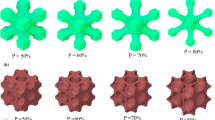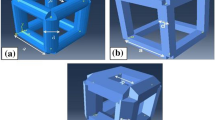Abstract
This paper presents a review of the strategies for the design and development of heterogeneous porous scaffolds. Once the lattice structure (scaffold) is designed with the help of computer-aided design (CAD) software, analysis is done to investigate its compressive response with finite element analysis (FEA). The stiffness of the scaffold is calculated and compared with that of a compact bone and validated experimentally with the help of 3D printing of the scaffold. Heterogeneity of both types, i.e. structural and material, helps mimic the structure of human bones as human bones are porous, heterogeneous and anisotropic. Topology optimization of lattice structure is performed to achieve a high surface area to volume ratio of the scaffold so that cell proliferation and vascularization can be increased. Porosity, pore interconnectivity and pore size are varied to achieve the desired properties in the scaffold to match the stiffness of the scaffold with that of humane bone. Metallic biomedical materials that are investigated in the reported works include stainless steel SS 316L (~210 GPa), Co–29Cr–6Mo alloy (~210 GPa), Ti–6Al–4V alloy (~110 GPa) and Mg alloy (~45 GPa). All the above materials have stiffness greater than that of the cancellous bone (0.02–2 GPa) and the cortical bone (3–30 GPa) which creates a stress shielding effect after implantation in the bone. To avoid the stress shielding problem, these materials are made porous to decrease the stiffness of the solid material. Porosity is not only used for reducing the stress shielding effect but is also used for cell proliferation and vascularization. The objective of this review is to reflect on the heterogeneous porous scaffold design process detailing various phases like material and structural heterogeneity. The current literature on the design of heterogeneous porous scaffold is mainly focused on discussing structural heterogeneity and not much focused on material heterogeneity and there is very little work that reports both structural and material heterogeneity. Thus, there is a clear lack of a comprehensive view. This paper acts as a bridge among the main research outcomes available in the literature related to the design optimization and modelling of the heterogeneous porous scaffolds.
Access this chapter
Tax calculation will be finalised at checkout
Purchases are for personal use only
Similar content being viewed by others
References
Chen Q, Thouas GA (2015) Metallic implant biomaterials. Mater Sci Eng R 87:1–57
Slaoui I, Stephenson MK, Rauf HA, Dow DE, Shady SS (2015) Stress analysis of bone scaffold designed for segmental bone defects. In: Proceedings of the ASME international mechanical engineering congress and exposition IMECE2015, November, Houston, Texas pp 13–19
Calori GM, Mazza E, Colombo M, Ripamonti C (2011) The use of bone-graft substitutes in large bone defects: any specific needs? Injury. Int J Care Injured 42:S56–S63
Ghomi ER, Khosravi F, Neisiany RE, Singh S, Ramakrishna S (2020) Future of additive manufacturing in healthcare. Curr Opin Biomed Eng 1–15
Muthuvijayan V (2021) Tissue engineering scaffolds: extracellular matrix. A NPTEL online course, IIT Madras. www.youtube.com/watch?v=x5qgWRW-xm8, Last accessed 29 May 2021
Singh P, Shrivastava V, Abhash A, Yadav BN, Singh IB, Mondal DP (2021) Compressive deformation and corrosion behaviour of moderate to highly porous Ti-4Al-4Co (wt%) alloy foam. Mater Chem Phys 257(123718):1–12
Abhash A, Singh P, Ch VAN, Sathaiah S, Kumar R, Gupta GK, Mondal DP (2020) Study of newly developed Ti-Al-Co alloys foams for bioimplant application. Mater Sci Eng A 774(138910):1–17
Jain H, Mondal DP, Gupta G, Kothari A, Kumar R, Pandey A, Shiva S, Agarwal P (2021) Microstructure and high temperature compressive deformation in lightweight open cell titanium foam. Manuf Lett 27:67–71
Liu Y, Zheng G, Letow N, Zhao YF (2020) A survey of modeling and optimization methods for multi-scale heterogeneous lattice structures. J Mech Des
Gomez S, Vlad MD, Lopez J, Fernandez E (2016) Design and properties of 3D scaffolds for bone tissue engineering. Acta Biomater 42:341–350
Gupta V, Tandon P (2015) Heterogeneous object modeling with material convolution surfaces. Comput Aid Des 62:236–247
Gupta V, Tandon P (2017) Heterogeneous composition adaptation with material convolution control Features. J Comput Inf Sci Eng 17(2):1–10
Singh SK, Tandon P (2017) Comparison of heterogeneous modeling based different patterns of hip prosthesis design. In: Proceedings of the world congress on engineering and computer science, vol 2(October). San Francisco, USA, pp 25–27
Singh SK, Tandon P (2018) Heterogeneous modeling based prosthesis design with porosity and material variation. J Mech Behav Biomed Mater 87:124–131
Dong G, Tang Y, Li D, Zhao YF (2020) Design and optimization of solid lattice hybrid structures fabricated by additive manufacturing. Addit Manuf 33:1–12
Tan C, Cheq Y, Duan Y, Weng F, Sui S, Ng FL, Du Z, Bi G (2021) Additive manufacturing of multi-scale heterostructured high-strength steels. Mater Res Lett 1–10
Ptochos E, Labeas G (2012) Shear modulus determination of cuboid metallic open-lattice cellular structures by analytical, numerical and homogenization methods. J Strain 48:415–429
Miao X, Sun D (2010) Graded/gradient porous biomaterials. Materials 3(1):26–47
Leary M, Mazur M, McMillan M, Chirent T, Sun Y, Qian M, Easton M, Brandt M (2016) Selective laser melting (SLM) of ALSI12MG lattice structures. Mater Des 98:344–357
Giannitellia SM, Accotob D, Trombettaa M, Rainer A (2014) Current trends in the design of scaffolds for computer-aided tissue engineering. Acta Biomater 10(2):580–594
Author information
Authors and Affiliations
Corresponding author
Editor information
Editors and Affiliations
Rights and permissions
Copyright information
© 2023 The Author(s), under exclusive license to Springer Nature Singapore Pte Ltd.
About this paper
Cite this paper
Mall, A.P., Tandon, P. (2023). Design and Development of Heterogeneous Porous Scaffold—A Review. In: Gupta, V.K., Amarnath, C., Tandon, P., Ansari, M.Z. (eds) Recent Advances in Machines and Mechanisms. Lecture Notes in Mechanical Engineering. Springer, Singapore. https://doi.org/10.1007/978-981-19-3716-3_56
Download citation
DOI: https://doi.org/10.1007/978-981-19-3716-3_56
Published:
Publisher Name: Springer, Singapore
Print ISBN: 978-981-19-3715-6
Online ISBN: 978-981-19-3716-3
eBook Packages: EngineeringEngineering (R0)




